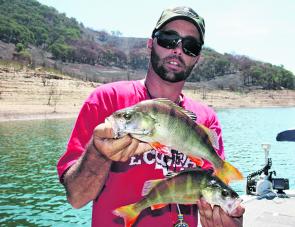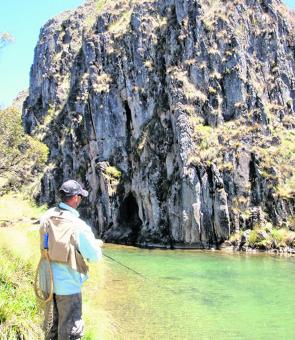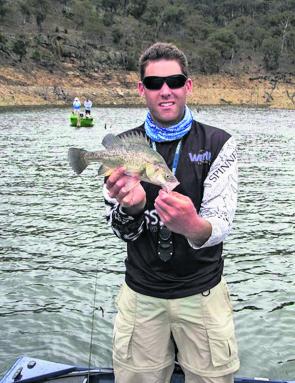I love fishing at this time of the year. The tree-lined creeks and rivers with the stunningly coloured autumn leaves on poplars and willows make for some amazing backdrops whilst fishing. These picturesque surroundings are also handy when it comes to photographing your catch, as they make most fish look even more stunning then they already do at this time of year. If you’re targeting trout, they will be in full spawn colour; add to that the stunning backdrop and even the worst photographer will get some good shots.
The official trout season closes in early June so there is not long left in the season. Once the season is closed anglers will be forced to fish the lakes for their trout fix, so it makes sense to concentrate your efforts on the running stuff while you still can. The best fishing to be had in the running water is almost always this late in the season, as many a big brown trout attempts to spawn – and if the rainbows aren’t thinking about it themselves they will more then likely be gorging on the eggs being deposited by the big browns. The fish being this active makes for some spectacular fishing and at this time of the year there is always the added possibility of the next trout you hook being one of trophy size.
While targeting trout at this time of the year it is hard to beat anything that is egg coloured. If you’re bait fishing then it will be hard to beat the good old brightly coloured dough baits like Powerbait and the like. Lure anglers will do well on any flashy lure, especially ones with any red or orange on the lure. Alternatively, brown or rainbow trout coloured hardbodies will also work really well, as most fish are very aggressive and competitive at the moment so they will strike any lure that resembles some sort of competition for them.
Fly anglers will definitely do best with weighted and even un weighted glo bugs at this time of year, and even though the purists frown upon this there is no mistaking its effectiveness. To cover both bases I like to use two flies under an indicator, one a glo-bug and the other a weighted black or red copper john nymph. That way, if the fish aren’t eating eggs they will still take the nymph.
Trout lake fishing can also be great at this time of the year. A lot of the browns will have started to head up the feeder rivers and streams but there will still be a few around in the lakes. There will also be a few rainbows around gorging themselves before their annual spawning migration up the feeder rivers and streams.
No matter what lake you fish or technique you choose to use, a lot of the resident fish will be holding around the creek and river mouths so it would pay to concentrate your efforts there.
This month most anglers will switch from targeting the natives to targeting the redfin, and with good reason: redfin are often easy to catch at this time of the year, they taste sensational and the natives have become very hard to catch.
Around this time of the year the redfin form much larger schools than they do during the warmer months. This means that once you find one you are normally in the vicinity of at least another hundred.
Trolling is a popular way of targeting and locating them, and any small hardbodied lure less than 60mm in length that dives to around the 40ft mark should see you stumble across some redfin action. Add a small 1” soft plastic around a metre above your chosen lure and you will increase your chances of a double hook-up (although a DH can occur even when just using one lure).
The hot place to be for a yella fix at the moment is the ever-reliable Burrinjuck Dam. Bait anglers and lure chuckers have certainly fared the best, with trolling being very hit and miss.
The key to success over the last few months has been fishing the trees, either with small yabbies or with soft plastics. Finding fish can be done in one of two ways: by trial and error, or by using a good quality fishfinder to help you save time. If you opt to go the hit-and-miss technique, simply jump from tree to tree until you find a tree that is holding fish. If you’re using a sounder to find fish, go from tree to tree until you find a tree showing fish, then fish it! Bait anglers simply need a paternoster rig, and it doesn’t hurt to have two baits down to increase your chances in the trees (just remember that you will lose more tackle this way).
With the plastics it is hard to beat the ever-reliable Berkley Gulp Minnow grubs, Ecogear Grass Minnows and Bozo Smelts. All of these plastics will catch yellas but to increase your chances try to stick to natural coloured plastics, as these work far better then any other colours.
The retrieve is simple, just drop your plastic down through the tree’s limbs until you hit the bottom, then slowly retrieve the plastic back up through the trees. Hits will come at any time during the retrieve, so stay on the ball throughout the entire retrieve.
Most of the redfin you catch using this technique are schooled fish, which means they are generally smaller fish. However, what they lack in size they well and truly make up for in numbers; catching 10 or more fish off the one tree is not uncommon. The smaller fish are far better eating then the large fish anyway, so if you would like to catch a few for the frying pan it certainly pays to give these techniques a go.
Reads: 1322
Redfin of this size have been a tough proposition at Blowering over the last few months, that should change this month as these fish form larger schools and become much more active. These two fish were part of a large haul caught slow rolling Ecogear Gras

Now is the time to get out and fish the running water in hope of a big trout. They are actively feeding and/or spawning, making them easy to catch at times.

Vertically working the trees with bait or plastics has been the gun technique for landing golden perch at Burrinjuck Dam lately. Most fish are small but what they lack in size they make up for in numbers.




